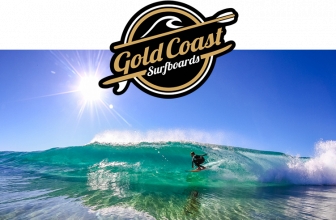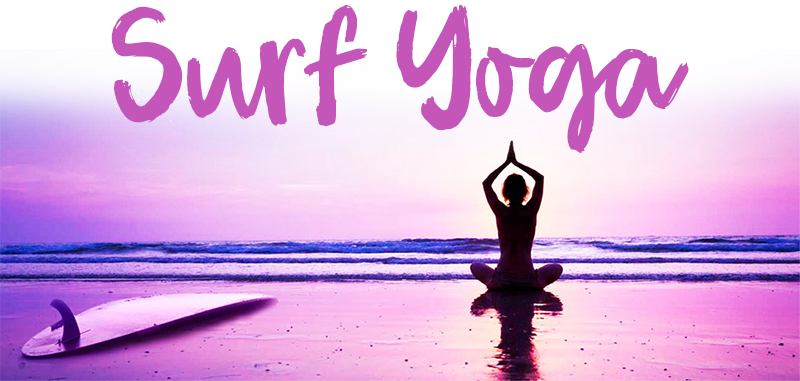
No matter what level of surfer you view yourself as, beginner or veteran, you should be practicing yoga alongside your wave riding.
More...
Yoga is one of the best ways to loosen up your body and put your agility and balance in order so that you can make the most of the surf.
While surfing can be one of the most fulfilling feelings, mentally and spiritually, it can take a major toll on your body.
Ask any surfer out there and they’ll tell you how much a literal pain in the neck surfing can be. This is why we wanted to create a definitive guide on yoga for surfers.
Before we get into the gritty details, let’s discuss why you should even consider the practice.
How Can Yoga Help Your Surfing
Yoga For Surfing Benefits
- Surf yoga can help with pain that is present in the neck, shoulders, and back
- Yoga for surfing can improve your flexibility
- Yoga for surfers can increase flexion and extension in your joints
- It can increase your core power
- It can help you build your stamina
- It helps you to lock in your physical balance and recognition
- It speeds up the recovery period after a surf
- It helps to bring equilibrium to your muscular structure
- Helps to enhance your posture
- It teaches you how to breathe more efficiently
- It aids in injury prevention
- It promotes mental focus and awareness
- It revitalizes and reenergizes your mind and body
- Surf yoga can improve your mood

Which Top Surf Pros Do Yoga?
Tom Carroll
Tom Carroll is world renowned as one of the best surfers of all time.
He’s been crowned the world surfing champion two times, and even in his later years, continues to push the boundaries of surfing by searching the globe for the world’s greatest waves.
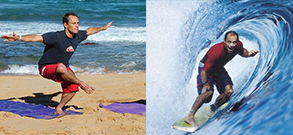
Even with all of his success in the sport, Tom Carroll still makes practicing yoga a part of his pre and post-surf routine. He notes that yoga helps him to “find his calm in the center of chaos” and “connect with his breath on the deepest level”.
Kelly Slater
For those of you who don’t know, Kelly Slater is probably the most popular surfer to have ever walked the face of the earth. The nine-time surfing world champion practices yoga regularly as cross training to stay in shape. He says that, “a lot of his injuries come from stiffness and imbalances”.
Alex Martins
Alex Martins is one of the kings of big wave surf in Brazil. The waves that he rides are pretty much as tall as seven or eight-story buildings. He notes that his daily Ashtanga practice is the thing that enables him to ride these massive waves.
Top 15 Yoga Poses For Surfers
5 Best Pre-Surf Poses
#1 Tai Chi Circles
Helps: Facilitate the Accumulation of Energy in the Body
How To: Interlace your fingers and extend your arms upwards over your head. Reach to one side of your body, slowly bend your knees, and circle your body around to the other side. Make sure that you keep your back flat, neck straight, and torso parallel to the ground. Continue to breathe and circle a few times, changing direction a few rotations in.
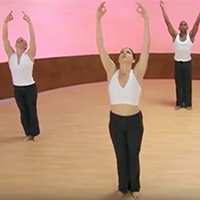
#2 Horse Stance
Helps: Create Strong and Flexible Hips
How To: Place your feet a few inches beyond your shoulder, keeping your heels facing slightly inwards behind you, as if you are going into a deep squat. While keeping your hips tucked under and your back and neck straight, grip the ground with your feet and open your knees as much as you can without compromising the above. If you’re doing the squat correctly, you should not be able to see your toes. Make sure that you stay relaxed and breathe deep. You may continue to drop lower as long as you maintain the proper alignment. Eventually you can add resistance to push deeper.
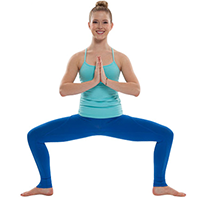
#3 Pigeon Pose
Helps: Improve posture and alignment in the body
How To: Begin by taking a knee on the floor and stretching your left leg out behind your body. Take your right knee into a bend so that your right foot inches toward your pelvic bone in a pointed toe fashion. Try to rest your right knee on the ground and lean into it, keeping your chest raised to the sky. You may keep your hands on the ground on either side of you to retain balance. Make sure to breathe deeply and hold the pose for at least 30 seconds. When you finish the pose, you can switch to the other side.
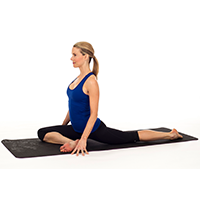
#4 Seated Forward Bend
Helps: Stretch Out the Lower Back, Hamstrings, and Hips
How To: Sit on the ground with your legs together straight out in front of you and sit up with your back straight. Inhale and lift your hands over your head and lengthen your body by stretching your fingertips to the sky. As you exhale, bend yourself at the hips and slowly bring your chest into your legs while trying to reach your hands as far as you can to your toes or ankles. If you want a deeper stretch, you can push through your heels to bring your toes closer towards your head. Hold this pose for at least 30 seconds while continuing to breathe deeply.
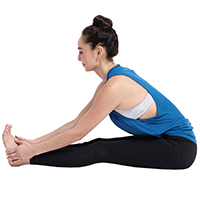
#5 Standing Forward Bend
Helps: Stretches the Hips, Hamstrings, and Calve; Strengthens the Spine
How To: Begin by standing straight in mountain pose while gently resting your hands on your hips. Inhale and, on your exhale, slowly bend forward using your hip joints as your hinges instead of your waist. Draw your belly into your back and keep your focus on lengthening your upper body. Make sure to keep your knees straight while aiming to put your hands either on the floor next to your feet or wrapped around the back of your ankles. You may also cross your forearms and cradle your elbows while bending your knees to get a deeper stretch. Hold for at least 30 seconds while continuing to breathe.
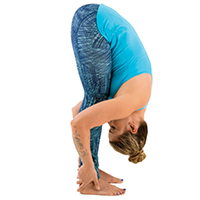
5 Best Big Surf Yoga Poses
#1 Goddess Pose
Helps: Activate the Legs and Quads; Stretches Groin and Hips
How To: Spread your feed about 3 feet apart from each other and turn your toes so that they are facing 45-degrees outwards. Exhale slowly and bend your knees so that they are parallel to the ground. Your knees should now be directly over your feet. Raise your arms so that they are shoulder height and face your palms towards each other. With your eyes to the sky and your back straight, raise your arms above your head and elongate your spine. Hold this pose for approximately 30 seconds while continuing to breathe deeply.
#2 Warrior II
Helps: Strengthens the Legs; Opens the Hips and Chest
How To: Begin by standing in mountain pose. Exhale slowly and step your feet so that they are about 4 feet apart. Raise your arms out to each side so that they are facing parallel to the floor and extended out from each side of your body. Make sure that your shoulder blades are wide and that your palms are facing down. Turn your right foot a bit to the right and your left foot to a complete 90-degrees. Both heels should be aligned. Slowly exhale and bend your left knee so that it is directly over your left ankle with your shin perpendicular to the ground. Press down on your tailbone and hold for approximately 30 seconds while continuing to breathe. Repeat on the opposite side.
#3 Plank Pose
Helps: Builds Strength and Stability in Your Core and Shoulders; Improves your Pop-Ups
How To: Begin by getting on all fours with your hands placed flat on the floor directly under your shoulders. Spread your fingers apart making sure that your palms are completely touching the floor. Tuck your toes under and lift your legs so that they are straight like in a push-up position. Your hips and shoulder should all be on one even plane. Draw strength from your core to help support your spine and keep your alignment straight. Make sure that your neck is long and continue to breathe while holding for at least 30 seconds.
#4 One-Legged Chair Pose
Helps: Improves Strength and Core Balance; Opens Hips
How To: Start out in awkward chair pose (utkatasana) and take a few slow, deep breaths with your feet rooted into the ground. Your weight should be in the back of your heels. Bring your palms together over your heart and slowly lift your right foot off the ground. Bend your left knee slightly and cross your right ankle over it so that it rests on your thigh just above your knee. Your right foot should be flexed and your right leg’s shape should be somewhat of a triangle. Hold this pose for at least 30 seconds while continuing to breathe deeply.
#5 Locust Pose
Helps: Strengthens the Entire Back of the Body
How To: Lie flat on your stomach with your hands placed under your shoulders. Keep your legs and ankles together and pointing straight back. Stretch your torso away from the lower half of your body and reach your legs through your toes. Inhale slowly, and, on the exhale, press your pelvis down into the ground and lift your hands and feet off the ground. You entire spine (not just your neck) should be lifted, energized, and strong, so that you don’t feel tightening or extreme discomfort in the lower back. Do this in a few 20-30 seconds reps while breathing each time.
5 Best Post-Surf Yoga Poses
#1 Extended Puppy Pose
Helps: Stretches out the Spine and Shoulders
How To: Come down onto all fours with your arms under your shoulder and palms on the floor. On your exhale, walks your hand forward and place your forehead on the floor in front of you. If you can’t get your forehead there, your chin is fine. Your arms should remain active so that your elbows aren’t resting on the floor. While keeping your back in a slight curve, pull your butt back to lengthen your hips and your spine. Hold this for around 30-60 seconds while taking a few deep breaths. Slowly exhale in the last few seconds and sink down onto your heels.
#2 Bow Pose
Helps: Stretches your Abdomen and Chest; Strengthens Your Upper Back Muscles
How To: Lie face down on your mat with your arms resting beside your body, keeping your palms up. On your exhale, activate your core and bend both of your knees back towards your head so that you are able to grab on to your ankles. Inhale deeply, but into your chest, so that you feel your chest expanding and raising. Keep your chest raised and press your ankles back into your palms. Focusing on pressing your shoulder blades back is a great way to get the opening sensation in your heart. Remain in the position for around 30 seconds while breathing deeply. Exhale in the last few seconds and slowly lower yourself to the floor.
#3 Extended Side Angle Pose
Helps: Stretches the Shoulders, Chest, Spine, and Waist; Releases Tension in the Hips
How To: Begin by entering mountain pose. Step the feet out so that they around 3-4 feet apart. The outsides of your feet should be facing directly to the left and right of your torso. Turn your right foot out slightly, keeping it in alignment with the heel of your left foot. While keeping your hips facing forward, inhale and lift your arms up so that they are shoulder height and parallel to the ground. Bend your right knee slowly, keeping it behind the ankle, and look over your right shoulder. Inhale and gently place your right arm on your thigh while keeping your core activated. Exhale and lift your left arm up, keeping your head and spine nicely aligned. Inhale and reach to the sky. Stay firmly planted and breathe deeply, holding on each side for about 30-60 seconds.
#4 Lord of The Fishes
Helps: Improves Hip Joint and Spine Rotation; Relieves Fatigue
How To: Sit on your mat with your left knee bent and your left foot close to your right buttock. Place your right foot on the outside of your left knee, making sure that your butt bones are both touching the floor. Inhale and reach your arms towards the sky to create length in the spine. Exhale slowly and rotate your body to the ride, letting your core do most of the work. Your head should be the last thing to turn. Place your elbow on your right knee and place your right hand behind your back to stay supported. Remain in the position for at least 30 seconds while breathing deeply before unwinding back to the first position.
#5 Reclined Spinal Twist
Helps: Releases Tension in the Spine; Stretches the Shoulders
How To: Lie flat on your mat or on the ground and bend your right leg so that your right toes hook under your left knee. Exhale and slowly move your right knee around your body so that it touches the floor on the left side of your body. Make sure that your shoulders stay flat on the mat. If you can’t touch your knee without keeping your shoulders flat, only go as far as you can go. Inhale and stretch your right arm directly out to the right side. Hold this position for around 30-60 seconds while continuing to breath deeply.
How To Get Started
Class or At-Home
We highly recommend starting out by taking a class, as it always helps to have an expert around to make sure that you are practicing properly. It can be difficult to monitor yourself if you’re alone. If you don’t have the option of taking a class, you should look online to find videos of instructors teaching beginner routines. Make sure that the yoga routine you begin to practice is one that is catered to your needs. In your case, most likely, that routine will include some of the poses above and be catered to surfers. You should also make sure that the yoga routine has versatility so that it focuses on all points of the body and breath, rather than just one.

Creating Space for At-Home Practice
Even with classes available, most of us surfing yogis like to be able to practice when we’re at home. For this, there are a couple things you’ll need. First thing you should do is find a quiet place in your home (we recommend outside if you can) that is free from clutter or distractions. Your “game room” is probably not the best choice for a practice space. Make sure that you stock this area with essential yoga tools such as a mat, straps, blocks, blankets, bolsters, etc. You don’t need a giant space to practice yoga, just enough room so that you feel free, open, and relaxed.
Create Goals
You won’t become a yogi master in the span of a day. You also won’t become a yogi master if you don’t keep your practice routine consistent. We recommend that you start out small. Try and at least get in 10-15 minutes of practice a day and keep your routine fairly small. An example of a good goal is to perfect your technique on one of your poses.
Don’t Underestimate Beginner Sequences
Many surfers who begin practicing yoga underestimate how difficult it is to get right. They feel that they are already very active and in shape, so they attempt to hit poses that are far beyond their technical abilities. Make sure that you start by building a solid foundation of beginner yoga poses into a sequence that fits your needs.
Frequently Asked Questions
How Can I Stay Motivated to Practice Yoga Every Day?
Having the right space and the correct sequence in mind to begin practicing is only a start. The best thing we can recommend is to start your yoga routine right after you get out of bed. Sit down and look at your weekly to do list.
Carve out at least 15 minutes every morning to get up and practice yoga. Staying motivated is truly just not making excuses as to why you can’t practice. As the day goes on, it’s so much easier to say that “there’s no time” or you’re “too tired” to practice your routine.
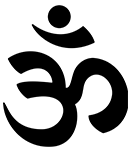
Another great way to stay motivated is to keep your routine dynamic. Explore different yoga and flow routines while remaining curious and being creative. Again, don’t over-reach and practice things beyond your ability, but maybe find a few full-body routines and swap them out for each other over the course of the week.
The last thing we recommend you doing is practicing with someone. Whether it’s a friend, significant other, family member, or even your dog, being on the mat with someone right next to you is a great way to share and reflect positive energy. You also help keeping each other motivated by pushing each other to do better, hold poses longer, and make sure technique is right.
Can I listen to Music While Doing Yoga?
Yes and no. There are a few things you should consider when turning on music for yoga practice. If you must have music, make sure that it is purely instrumental. Music with lyrics adds extra stimulus to the brain and tends to be more of a distraction than anything. Instead of focusing on your breath and body, your brain focuses on the melody, the harmony, the words, the emotion, the meaning of the lyrics, and so on.
Music can also have a detrimental effect on your practice routine, as it defeats the spiritual and meditative aspect of yoga. Much of yoga is a quiet, mantra-based practice that allows you to look deep inside of you, focus on your breath, and quiet your mind. While music may make you happy, cheerful, or bring nostalgia to your soul, it can, in a strange way, be innately stressful, especially if it is loud.
To make it clear, silence is a better way to practice yoga.
Do I have to Om when I practice?
The act of saying Om is a mantra that is traditionally spoken at the beginning and end of yoga routines. It came to practice as a way to mimic the vibration of the universe. The first yogis believed that the earth and universe were in constant motion, creating energy and vibration. Little did they know, as scientists will tell us today, their theory was correct. Though the things in our world don’t make a literal ‘Om’, you can hear and feel energy that is similar in many places around you. The wind blowing on shore, the waves crashing on the beach, the sound of putting your ear into a conch shell, are all examples of this energy. While you don’t have to chant Om while you practice, it helps to experience reflection of our universe. It can also be extremely uplifting and help to soothe your body and mind after a long session.
How Is Yoga Different From other Forms of Cross-Training?
Yoga goes far beyond regular forms of stretching or fitness and it is far more than just aligning your posture. The physical aspect of yoga, though prominent, is just one piece of the puzzle. Yoga is unique to other activities in that it helps to connect the mind, body, and breath, by utilizing our natural fluctuations and energy. We’re able to direct our attention inward and recognize our thoughts, fears, and habits, from a different perspective. Yoga can help bring awareness to our lives, making us more flexible mentally and spiritually. For surfing specifically, it can help us to overcome the fear of that next big wave, control our nerves for our next competition, or just appreciate the ocean as an entity that is connected to us deeply.


